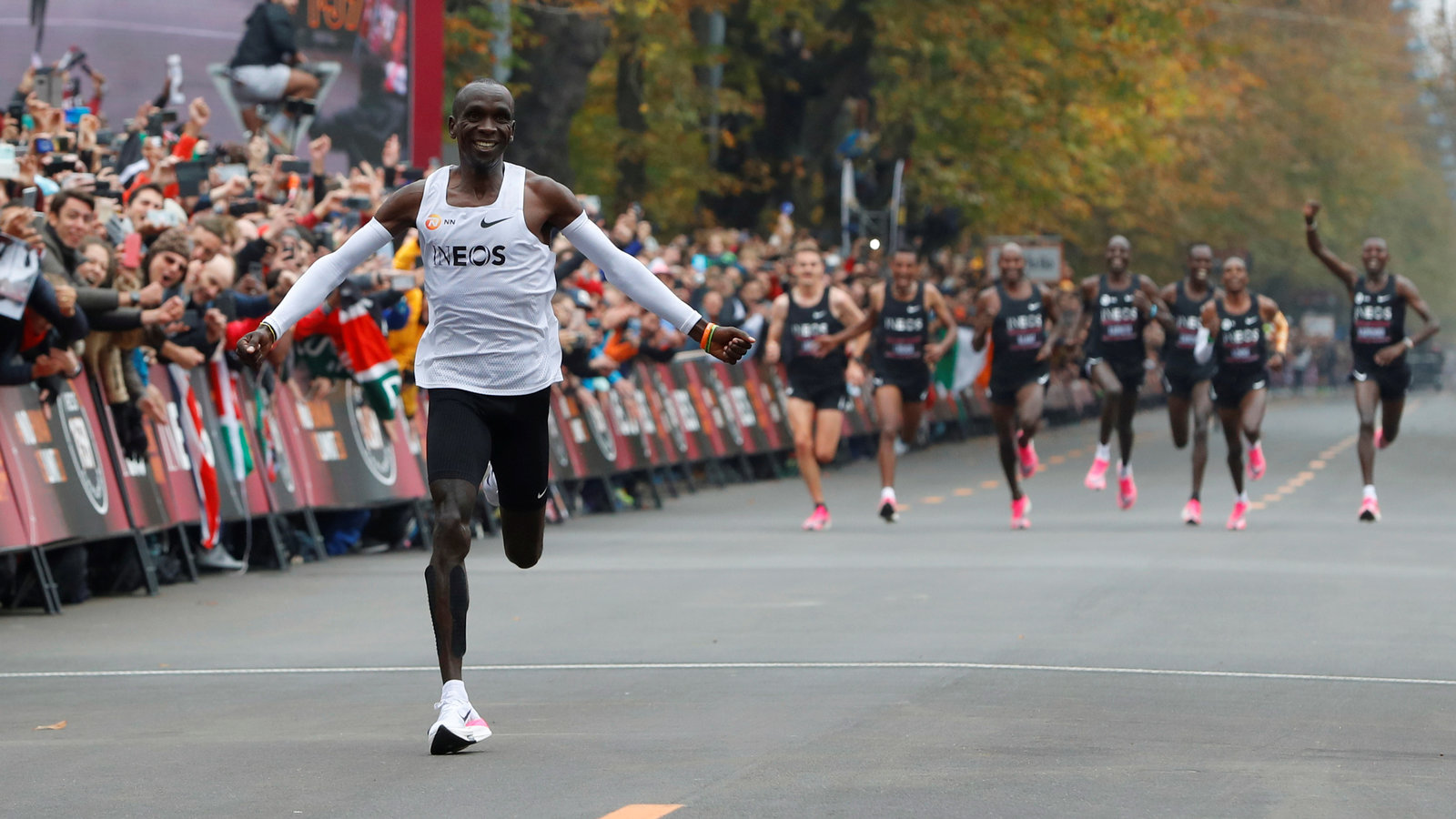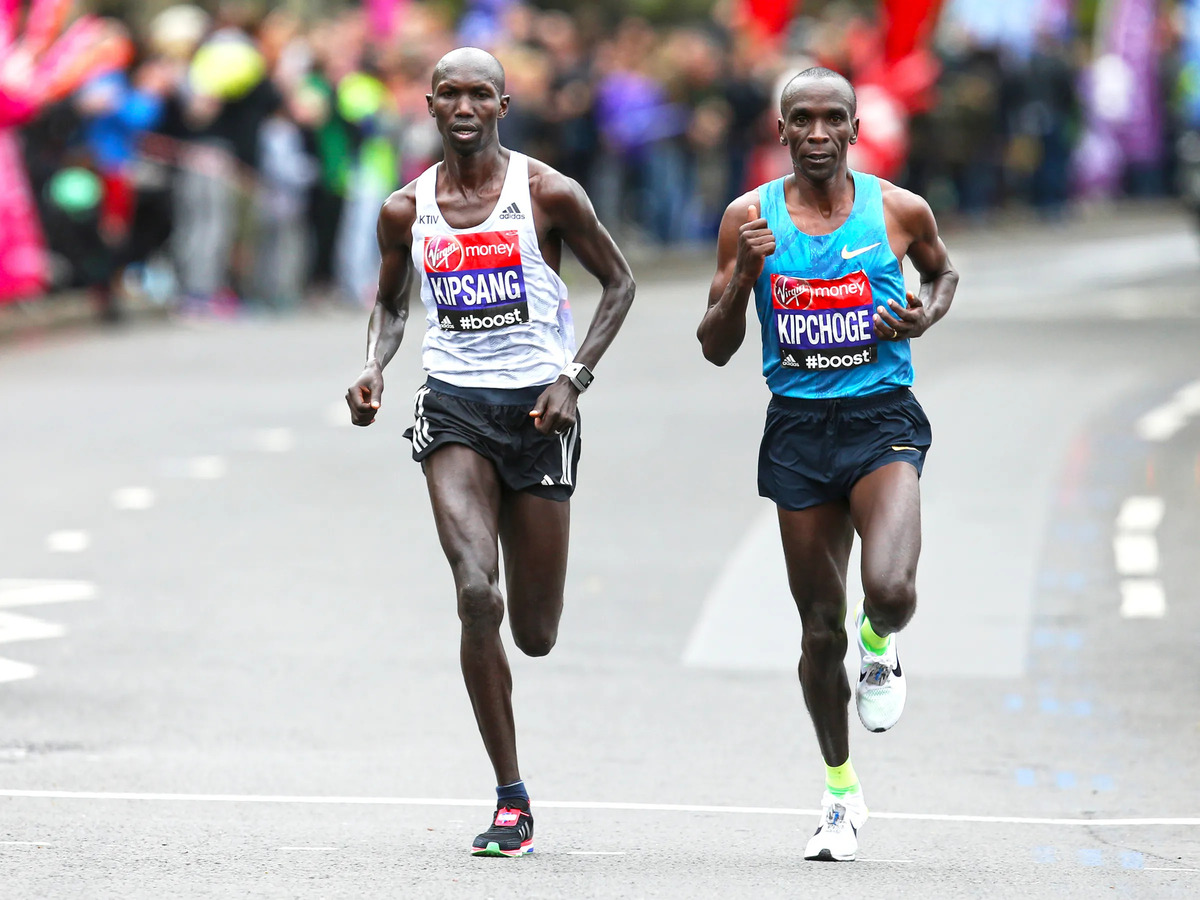

Featured
What Pace For 4-Hour Marathon
Modified: January 22, 2024
Discover the perfect pace for your 4 hour marathon with our featured guide. Enhance your training and achieve your goal with expert tips and techniques.
Introduction
Running a marathon is a daunting challenge that requires months of training, dedication, and mental fortitude. For many runners, the goal of completing a marathon in under 4 hours is an attractive benchmark. Achieving this milestone requires careful planning, disciplined training, and a solid understanding of marathon pacing.
In this article, we will delve into the specifics of running a 4-hour marathon, exploring the factors that affect pace, training strategies to improve speed and endurance, as well as nutrition and race-day tips. Whether you are a seasoned runner aiming to improve your marathon time or a first-time marathoner with an ambitious goal, this article will provide you with valuable insights to help you reach your target.
Running a marathon at a 4-hour pace equates to maintaining an average speed of about 9 minutes and 9 seconds per mile (or 5 minutes and 41 seconds per kilometer). It requires a combination of speed, endurance, and mental toughness. Each runner’s journey to a 4-hour marathon is unique, and it’s important to remember that progress takes time and consistency.
By understanding the various factors that influence marathon pace and incorporating effective training strategies into your routine, you can increase your chances of achieving your goal. This article will guide you through the process, providing practical tips and advice to support you on your marathon training journey.
So, lace up your running shoes, tighten your laces, and let’s dive into the world of training and pacing for a 4-hour marathon!
html
Understanding the 4-Hour Marathon Goal
The 4-hour marathon goal is a popular milestone for many runners, as it represents a balance between challenging oneself and achieving a realistic performance. While elite runners effortlessly complete marathons in well under 2 hours, the majority of runners find a 4-hour finish time to be a significant accomplishment.
When setting the goal of a 4-hour marathon, it’s essential to understand the average pace required to achieve this time. Running at an average pace of 9 minutes and 9 seconds per mile (or 5 minutes and 41 seconds per kilometer) will enable you to finish the 26.2-mile (42.2 km) distance in just under 4 hours.
It’s important to remember that marathon pacing is not linear. While some runners may maintain a consistent pace throughout the entire race, others may start slower and gradually increase their speed, or even opt for a negative split strategy (running the second half faster than the first). Deciding on a pacing strategy should be based on your training, fitness level, and individual preferences.
To accurately assess your chances of achieving a 4-hour marathon, it’s helpful to analyze your current running ability. Consider factors such as your current 10K or half marathon race times, as these can provide a rough estimate of your potential marathon performance.
Keep in mind that the 4-hour marathon goal is not limited to experienced runners. Many first-time marathoners set this as their target, as it offers a reasonable and achievable objective. With the right training plan and determination, beginners can successfully cross that finish line within the desired time frame.
It’s important to have a realistic understanding of your capabilities and embrace the incremental progress you make. Running a marathon is a journey, and each step forward is a step closer to your goal.
html
Factors Affecting Marathon Pace
Various factors come into play when determining your marathon pace. It’s important to understand these factors as they can significantly impact your ability to maintain a consistent speed throughout the race.
1. Fitness Level: Your overall fitness level plays a crucial role in marathon pacing. The more trained and conditioned your body is, the easier it will be to maintain a faster pace. Consistent training, including long runs, tempo runs, and speed workouts, will help improve your fitness and endurance.
2. Training Plan: Following a well-structured training plan is essential for optimizing your marathon pace. A good plan will include a combination of distance runs, interval training, and tempo runs, gradually building your endurance and speed. It will also incorporate rest days to allow for proper recovery.
3. Weather Conditions: Weather can have a significant impact on marathon pace. Hot and humid conditions can make running more difficult, causing you to slow down. On the other hand, cool and favorable weather can contribute to faster running times. Be aware of the weather forecast and adjust your pace accordingly.
4. Course Profile: The elevation and terrain of the marathon course can greatly affect your pace. Flat and fast courses allow for a more consistent speed, while hilly courses may require strategic pacing and adjustments. Take into account the course’s elevation profile and plan your strategy accordingly.
5. Race Strategy: Your chosen racing strategy can influence your pace. Some runners prefer to start conservatively, aiming for a negative split, while others opt for a more even pace or even a positive split. It’s crucial to find a strategy that works best for you and aligns with your training and abilities.
6. Mental Toughness: Marathon running requires mental strength as well. Maintaining focus, staying motivated, and pushing through fatigue are essential for maintaining your desired pace. Mental training, visualization exercises, and a positive mindset can help strengthen your mental stamina.
Keep in mind that these factors can interact with one another. For example, if weather conditions are unfavorable, it may impact your fitness level and require adjustments to your race strategy. It’s important to be adaptable and make the necessary adjustments on race day.
html
Training Strategies for a 4-Hour Marathon
Preparing for a 4-hour marathon requires a well-planned and structured training program. Here are some training strategies to help you reach your goal:
1. Gradual Progression: Build your mileage gradually to avoid injury and improve endurance. Start with a comfortable base and increase your weekly mileage by no more than 10% each week. Incorporate a mix of easy runs, long runs, and speed workouts to build strength and speed.
2. Long Runs: Long runs are essential for marathon training. Gradually increase your long run distance to improve endurance and simulate the challenges of the race. Aim to complete at least one 20-mile run before race day to build confidence in your ability to finish strong.
3. Tempo Runs: Tempo runs involve running at a comfortably hard pace. These workouts teach your body to sustain a faster pace over an extended period. Start with shorter tempo runs and gradually increase the duration and intensity as your fitness improves.
4. Interval Training: Interval training involves alternating between high-intensity running and recovery periods. These workouts improve your speed, anaerobic capacity, and overall race performance. Incorporate intervals of various distances and durations to challenge your body and improve your ability to maintain a faster pace.
5. Strength and Cross-Training: Incorporate strength training exercises to build overall body strength and prevent injuries. Focus on exercises that target your lower body, core, and upper body. Additionally, cross-training activities such as swimming or cycling can provide aerobic conditioning while reducing the impact on your joints.
6. Rest and Recovery: Rest days are crucial for allowing your body to recover and adapt to the demands of training. Incorporate rest days into your training schedule to avoid overtraining and reduce the risk of injury. Listen to your body and take additional rest days if needed.
7. Consistency: Consistency is key in marathon training. Stick to your training plan, even when you face challenges or feel unmotivated. Trust the process, stay dedicated, and believe in your abilities. Consistent training will help you make progress and achieve your 4-hour marathon goal.
Remember, everyone’s training journey is unique, and it’s important to find what works best for you. Adjust your training plan as needed, listen to your body, and seek advice from experienced runners or coaches if necessary. With dedication, perseverance, and a smart training approach, you can achieve your goal of running a 4-hour marathon.
html
Weekly Mileage Recommendations
Determining the appropriate weekly mileage for your 4-hour marathon training requires careful consideration of your current fitness level and running experience. Here are some general recommendations to guide you:
1. Base Mileage: It’s important to have a comfortable base mileage before starting marathon training. Aim to run consistently for at least 3-6 months, gradually building up your weekly mileage to a minimum of 20-25 miles per week.
2. Mileage Progression: Build your mileage gradually over time to avoid overuse injuries. Increase your weekly mileage by no more than 10% each week. As you get closer to your race, you can aim for a peak mileage of 35-45 miles per week, depending on your training plan and individual capabilities.
3. Quality over Quantity: It’s important to prioritize the quality of your runs over sheer mileage. Incorporate workouts that focus on speed, endurance, and tempo runs throughout your training. These targeted sessions will be more beneficial in improving your overall marathon performance.
4. Long Runs: Long runs are a crucial component of marathon training. Gradually increase the distance of your long runs to build endurance and mental resilience. Aim to complete at least one long run per week, starting with 10-12 miles and gradually building up to 18-20 miles or more.
5. Recovery Runs: Include shorter recovery runs in your weekly mileage to aid in recovery and facilitate active rest. These runs should be done at an easy and comfortable pace, allowing your body to recover without adding excessive stress.
6. Listen to Your Body: Pay attention to any signs of fatigue, pain, or overexertion. If you feel excessively tired or experience unusual pain, it’s important to adjust your training and give your body adequate rest and recovery time. Remember, rest days are just as important as training days to prevent burnout and injury.
7. Individual Variation: Every runner is different, and what works for one person may not work for another. It’s important to assess your own capabilities, consult with a running coach if needed, and make adjustments to your training plan accordingly. Listen to your body and prioritize injury prevention and long-term sustainability.
By gradually increasing your mileage, incorporating quality runs, and listening to your body, you can find the optimal weekly mileage for your 4-hour marathon training. Remember, consistency and patience are key, and trust in the training process will ultimately lead you to achieve your marathon goal.
html
Long Run Distance and Pace
The long run is a crucial component of marathon training, helping to build endurance and mental resilience. When preparing for a 4-hour marathon, it’s important to carefully consider both the distance and pace of your long runs. Here’s some guidance to help you navigate this important training session:
1. Gradual Distance Increase: Start with a comfortable long run distance and gradually increase it each week. Aim to add 1-2 miles (or more, if you’re comfortable) to your long run distance every week. This progressive increase prepares your body for the demands of the marathon distance.
2. Simulating Race Distance: As you progress through your training, it’s beneficial to reach a peak long run distance that is similar to, or slightly longer than, the marathon distance. This prepares your body for the physical and mental challenges of running 26.2 miles.
3. Practice Marathon Pace: During your long runs, experiment with running at your goal marathon pace or slightly faster. This helps condition your body to sustain that pace for an extended period. However, it’s also important to include some long runs at an easy, conversational pace to focus on building endurance without excessive stress.
4. Negative Split Runs: Consider incorporating negative split runs into your training. This involves running the second half of your long run at a faster pace than the first half. This strategy helps strengthen your mental endurance and prepares you for maintaining a steady pace in the latter stages of the marathon.
5. Maintain Endurance: While pacing is important during long runs, it’s crucial to prioritize building endurance over speed. Avoid the temptation to push too hard and risk burnout or injury. Focus on completing the distance comfortably and gradually increasing your pace as your fitness improves throughout your training.
6. Recovery and Rest: Allow for proper recovery after your long runs. Schedule them earlier in the week to have sufficient time for rest and recovery before your next intense training session. Adequate rest and recovery will allow your body to adapt and become stronger.
7. Mental Preparation: Long runs not only build physical endurance but also mental fortitude. Use these runs as an opportunity to practice mental strategies such as positive self-talk, visualization, and staying focused. Developing mental toughness during long runs will help you overcome any challenges on race day.
Remember, each runner is different, and finding the right long run distance and pace may require some trial and error. Listen to your body, be adaptable, and make adjustments as needed. With a balanced approach, your long runs will play a significant role in preparing you to achieve your 4-hour marathon goal.
html
Tempo Runs and Interval Training
Incorporating tempo runs and interval training into your 4-hour marathon training plan can greatly improve your speed, endurance, and overall race performance. Let’s delve into these two key workouts:
1. Tempo Runs: Tempo runs involve running at a comfortably hard pace, just below your lactate threshold. This pace should feel challenging, but sustainable for a sustained period. Tempo runs improve your aerobic capacity, lactate threshold, and ability to sustain a faster pace.
During a tempo run, aim to maintain a steady pace for a sustained distance or time, typically ranging from 20 minutes to an hour. Start with shorter tempo runs and gradually increase the duration as your fitness improves. Incorporating tempo runs into your training plan once or twice a week can help improve your marathon pace.
2. Interval Training: Interval training involves alternating between intense running efforts and recovery periods. These workouts improve your anaerobic capacity, speed, and overall race performance. Interval training can be done on a track, road, or treadmill.
There are various interval session formats you can incorporate into your training plan, such as 400-meter repeats, 800-meter repeats, or pyramid workouts. The key is to run the intense segments at a fast pace, close to your maximum effort, followed by active recovery or rest periods. This helps improve your body’s ability to clear lactate and recover faster between intense efforts.
Gradually increase the duration and intensity of your interval workouts as your fitness improves throughout your training. It’s important to warm up properly before engaging in interval training and to include a cool-down period to aid in recovery.
3. Combining Tempo Runs and Intervals: To maximize your training benefits, consider incorporating both tempo runs and interval workouts into your training plan. Alternating between these two types of workouts can help improve both your speed and endurance, allowing you to maintain a faster pace for longer periods.
It’s important to balance these intense workouts with easy and recovery runs to avoid overtraining and reduce the risk of injury. Be mindful of your body’s signals and adjust the intensity or volume of the workouts as needed. Consistency and gradual progression are key for reaping the full benefits of tempo runs and interval training.
Remember, these workouts should be tailored to your fitness level and training goals. If you’re new to tempo runs or interval training, it’s advisable to consult with a running coach or experienced runner for guidance on incorporating these workouts effectively into your training plan.
html
Strength and Cross-Training
Strength and cross-training are essential components of your 4-hour marathon training plan. They help improve overall fitness, prevent injuries, and enhance your performance on race day. Let’s explore their benefits and how to incorporate them into your training:
1. Strength Training: Incorporating strength training exercises into your routine helps build muscle strength, enhance running economy, and prevent injury. Focus on exercises that target your leg muscles, core, and upper body. Examples include squats, lunges, deadlifts, planks, and push-ups. Aim for at least two strength training sessions per week, allowing rest days in between to promote recovery.
2. Cross-Training: Engaging in cross-training activities diversifies your workouts, provides aerobic conditioning, and reduces the risk of overuse injuries. Common cross-training activities for runners include swimming, cycling, elliptical training, and rowing. Choose activities that are enjoyable and complement your running routine. Incorporate cross-training sessions into your weekly schedule, aiming for 1-2 sessions per week.
3. Flexibility and Mobility: Don’t overlook the importance of flexibility and mobility exercises. Stretching, yoga, and foam rolling help improve range of motion, reduce muscle tightness, and enhance recovery. Dedicate a few minutes before and after each workout to stretch and foam roll your major muscle groups.
4. Core Stability: A strong core provides stability and improves running efficiency. Include exercises that target your core, such as planks, Russian twists, and mountain climbers. A stable core helps maintain proper running form and prevents excessive energy wastage.
5. Rest and Recovery: Remember that rest and recovery are just as crucial as training itself. Allow for rest days to give your body time to repair and adapt. Overtraining can lead to increased fatigue and higher injury risk. Listen to your body and be mindful of signs of overtraining, such as persistent fatigue, decreased performance, or frequent illness.
6. Periodized Training: Plan your strength and cross-training sessions in a structured and periodized manner. Coordinate with your running schedule to ensure proper balance and avoid excessive fatigue. Prioritize strength and cross-training on easier running days or rest days to maximize the benefits without compromising your running performance.
Remember, each runner’s needs and preferences are unique. Experiment with different strength exercises and cross-training activities to find what works best for you. Gradually progress the intensity and volume of your strength and cross-training sessions to match your marathon training goals.
By incorporating strength and cross-training into your routine, you’ll improve your overall fitness, reduce the risk of injuries, and support your marathon training efforts. Stay consistent, listen to your body, and enjoy the benefits of a well-rounded training plan.
html
Nutrition and Hydration Strategies
Proper nutrition and hydration are essential for fueling your body during marathon training and optimizing performance on race day. Here are some strategies to help you maintain a balanced and effective approach to fueling:
1. Balanced Diet: Focus on consuming a variety of nutrient-dense foods to provide your body with the energy and nutrients it needs. Include a combination of carbohydrates, protein, and healthy fats in your meals. Whole grains, lean proteins, fruits, vegetables, and healthy fats like avocado and nuts should be staples in your diet.
2. Carbohydrate Loading: Prior to the marathon, consider implementing a carbohydrate-loading strategy. This involves increasing your carbohydrate intake in the days leading up to the race to ensure glycogen stores are fully stocked. Consult with a registered dietitian or sports nutritionist for guidance on the appropriate carbohydrate loading protocol for your specific needs.
3. Pre-Run Fuel: Consume a light, easily digestible meal or snack 1-2 hours before your long runs or race day. This should consist mainly of carbohydrates to provide immediate fuel. Experiment with different options and quantities during training to find what works best for you and avoids any digestive discomfort.
4. During-Run Fueling: Practice your race fueling strategy during training to determine what works best for you. During long runs, consume a mix of carbohydrates and electrolytes to replenish energy stores and maintain hydration. Sports drinks, gels, energy bars, or real food options like bananas or dates are popular choices. Aim to consume 30-60 grams of carbohydrates per hour during long runs or on race day.
5. Hydration: Stay properly hydrated throughout your training and on race day. Determine your fluid needs by considering factors such as sweat rate, weather conditions, and personal tolerance. Hydrate adequately before, during, and after your runs. Sip water or a sports drink regularly during long runs to maintain fluid balance and avoid dehydration.
6. Recovery Nutrition: Proper recovery nutrition is crucial for muscle repair and glycogen replenishment. Consume a post-run meal or snack containing carbohydrates and protein within 30-45 minutes of completing your run. This helps promote muscle recovery and supports your body’s adaptation to training.
7. Individual Experimentation: Every runner is unique, so it’s essential to experiment with different fueling strategies and pay attention to how your body responds. Keep a training and nutrition journal to track what works best for you, and make adjustments as needed.
Remember, nutrition and hydration planning should be an integral part of your overall training strategy. Seek guidance from a registered dietitian or sports nutritionist to develop a personalized plan that meets your specific needs and goals. Maintaining proper nutrition and hydration will greatly contribute to your success in achieving your 4-hour marathon goal.
html
Race-Day Tips and Strategy
On race day, your training and preparation come together as you strive to achieve your 4-hour marathon goal. Here are some tips and strategies to help you perform your best:
1. Plan and Visualize: Familiarize yourself with the race course, including any elevation changes or challenging sections. Visualize yourself running strong and crossing the finish line within your goal time. Create a race-day plan that includes your pacing strategy, fueling plan, and hydration stops.
2. Start Slow: It’s tempting to get caught up in the excitement and start the race at a fast pace. However, starting too quickly can lead to burnout later on. Stick to your planned pace and allow yourself to settle into a comfortable rhythm before gradually increasing your speed.
3. Fuel and Hydrate: Stick to your practiced fueling and hydration plan. Consume small amounts of fuel and water at regular intervals to maintain energy levels and prevent dehydration. Pay attention to your body’s cues and adjust your intake if necessary, but avoid trying anything new on race day.
4. Break the Race Into Sections: Mentally divide the race into manageable sections, such as 5K or 10K intervals. Focus on completing each section rather than looking too far ahead. Celebrate small victories along the way to stay motivated and maintain a positive mindset.
5. Positive Self-Talk: Use positive affirmations and self-talk to stay motivated and overcome any doubts or challenges during the race. Remind yourself of your training and the hard work you’ve put in. Maintain a mindset of confidence, determination, and belief in your abilities.
6. Pace Adjustment: Depending on how you feel during the race, you may need to adjust your pace. If you’re feeling strong and have energy reserves, you can gradually increase your speed in the latter stages of the race. However, if you’re struggling, it’s important to stay focused and maintain a steady pace.
7. Soak in the Atmosphere: Don’t forget to enjoy the race-day experience. Take in the sights and sounds, cheer on fellow runners, and appreciate the crowd’s support. This positive energy can boost your spirits and propel you toward the finish line.
8. Stay Focused and Finish Strong: As you approach the final miles, dig deep and tap into your mental and physical reserves. Stay focused on your goal and maintain your pace. Visualize yourself crossing the finish line strong and achieving your 4-hour marathon goal.
Remember, every race is a learning experience. Regardless of the outcome, celebrate your achievements and learn from any challenges you may face. Embrace the journey and use it as motivation for future races and personal growth.
html
Conclusion
Congratulations on embarking on the journey to achieve your 4-hour marathon goal! Training for a marathon requires dedication, perseverance, and a strategic approach. By understanding the factors that affect marathon pace, implementing effective training strategies, and fueling properly on race day, you can increase your chances of reaching your goal.
Remember, progress takes time, and each runner’s journey is unique. Be patient with yourself and celebrate the small victories along the way. Trust in your training plan, listen to your body, and make necessary adjustments as needed. Stay consistent, stay motivated, and keep your eye on the prize.
As you cross that finish line and achieve your 4-hour marathon goal, remember to savor the moment and be proud of what you have accomplished. Running a marathon is not only a tremendous physical feat but also a testament to your mental strength and perseverance.
Whether this is your first marathon or a chance to set a new personal record, the lessons learned and the memories created along the way are priceless. Take what you have learned from this training experience and apply it to future races and challenges that come your way. Your journey as a marathoner has just begun!
So lace up your shoes, continue to set new goals, and keep pushing yourself to new heights. Your 4-hour marathon goal is within reach if you believe in yourself and put in the work. Best of luck, and may the road ahead be filled with joy, success, and endless miles of running!









